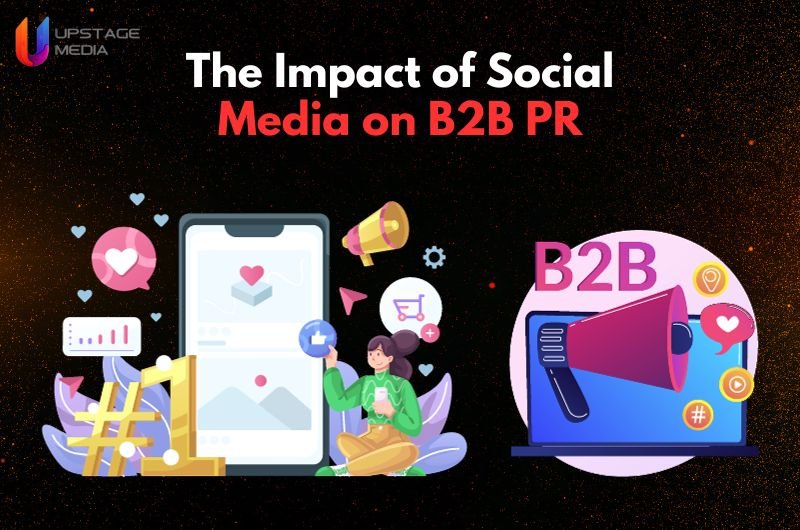Table of Contents
Social media has become a major factor in influencing B2B PR. Can directly communicate with potential new customers, show expertise, and build online communities at sites such as LinkedIn and Twitter.
This article demonstrates the development of B2B communications through social media. It outlines major platforms, advantages and disadvantages, best practices in use as well future trends. Social media is crucial nowadays for B2B companies to enhance awareness, relationships, and trust with audiences.
The Evolution of B2B Communication
The transformation in B2B communication has taken place from traditional ways to an unfolding digital landscape. Social networking sites such as LinkedIn and Twitter are major virtual meeting grounds where B2B relationships can be developed.
This is an integral part of successful strategies to promote B2B PR campaigns because businesses engage with real-time information, provide insider industry knowledge, and share insights engaging the stakeholders.
These are the three key components of a B2B Public Relations marking this transformative journey in business communication strategies, adapting to this digital era, understanding its platform nuances, and crafting targeted content.
Key Social Media Platforms for B2B PR
- LinkedIn: As one of the most frequently considered B2B professionals, LinkedIn is a platform for professional networking. It helps businesses to flaunt their expertise, display industry news, and network with potential clients and partners.
- Twitter: Twitter is a B2B Public Relations platform with a real-time nature. Companies can participate in industry debates, provide quick news, and interact with influencers and thought leaders.
- YouTube: B2B Public Relations Video content becomes more and more vital. YouTube provides businesses the opportunity to share product demonstrations, and interviews with thought leaders and add depth in terms of engaging content into their brand story.
- SlideShare: SlideShare is a place for sharing presentations and documents that were bought by LinkedIn. B2B professionals can use it to demonstrate their expertise, disseminate research results, and position themselves as authorities in the industry.
- Facebook Groups: While Facebook as such is mostly recognized in B2C-related interactions, industry-specific groups on the platform offer a more focused setting for B2B communication. Networking and visibility can be enhanced by engaging in relevant groups.
- Instagram: Instagram can be a visual influencer in B2B PR. Companies can provide information about what happens backstage, publicize events, and show the personal face of the brand.

Benefits of Integrating Social Media in B2B PR
- Enhanced Brand Visibility: B2B businesses are receiving a global platform to present their knowledge, goods, and services through social media platforms this again enhances brand awareness among its targeted markets.
- Enhanced Thought Leadership: B2B organizations that regularly deliver insightful content, industry updates, and useful information position themselves as thought leaders in their respective fields. This makes them believable and credible to their listeners.
- Real-Time Communication: B2B Public Relations specialists can interact with their partners, clients, and influential important people in the industry via social media in real-time. Immediacy permits prompt responses to consumer inquiries, developments in the industry, and events.
- Enhanced Stakeholder Engagement: By engaging oneself in the pertinent chats, commenting on articles, and publishing worthwhile content business-to-business establishments will be able to form much closer bonds with suppliers customers furthermore other members of their respective niche.

Challenges and Solutions
1. Consistent Brand Voice Across Platforms
Challenge: It is not easy to ensure that your brand voice remains consistent across multiple social media platforms.
Solution: Establish in-depth brand guidelines, train teams regularly, and use content calendars for unified messaging.
2. Effective Crisis Communication
Challenge: Social media crises must be managed through a well-structured plan.
Solution: Develop a comprehensive crisis communication plan with predetermined responses and appoint spokesmen to address the situation promptly.
3. Measuring Social Media ROI
Challenge: It is not easy to assess the impact of social media initiatives on business results.
Solution: Use analytics tools to track KPIs, review the data regularly, and adjust PR campaigns accordingly.
4. Adapting to Algorithm Changes
Challenge: Social media frequently influence organic reach and visibility through changes in algorithms.
Solution: Regularly reviewing algorithm updates, changing content formats, and paid advertising can mitigate impacts.
5. Balancing Global and Local Messaging
Challenge: B2B global companies need to be constantly uniform and unique at the same time.
Solution: Create core global messaging that can be locally adapted to make communication channels distinctly clear between the teams at the world level and in regional areas to align brands.
Best Practices in Social Media-driven B2B PR
1. Content Relevance and Value:
Making sure that content corresponds to the interests of audiences and presents helpful information. Concentrate on trends, thought leadership and solutions to be able to position your brand as an authoritative source.
2. Engagement with Stakeholders:
Engage influencers, partners, and customers in the industry. To comment, initiate conversations, and make people feel attached to your brand.
3. Data-driven Decision Making:
Utilize analytics tools that measure performance metrics. Collect data often to understand the behavior of your audience and figure out what works, and how it’s working so he would know which strategies can be transferred into future B2B Public Relations campaigns.
4. Influencer Collaboration:
Work with industry leaders to enhance your visibility. Install thought leaders who support your brand, and therefore gain credibility with people
5. Consistent Brand Messaging:
Make sure that the tone of the brand remains uniform on all social media platforms. Identify, and adhere to very strict brand guidelines so as to create consistency credibility, and uniformity of the message.
Also, the most effective practices for the creation of a successful B2B PR strategy are content relevance, Stakeholder Engagement, Data data-driven decision, influencer collaboration, and consistent brand messaging.
Future Trends and Prediction

Focusing on future trends in B2B PR, communicating through a one-to-one basis that is produced by artificial technology will become increasingly popular, and industry-specific platforms of social media for B are likely to develop as well the importance of live video interactive content maximizes.
Businesses should be prepared for such changes and remain dynamic to capitalize on the rewards associated with these new technologies, and methods of communication that are fast evolving in a highly mobile environment.
Conclusion
There are lots of exciting prospects for innovation and expansion in B2B PR in the future. Upstage Media is dedicated to developing current processes that combine traditional and digital techniques, while the enterprise changes.
Upstage Media positions itself at the leading edge of the dynamic B2B verbal exchange area by embracing emerging trends, overcoming barriers, and placing great practices into exercise. This guarantees ongoing achievement and an effective brand presence.
